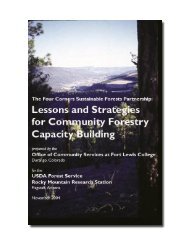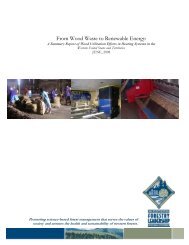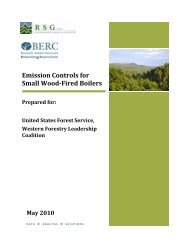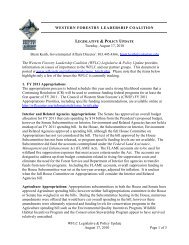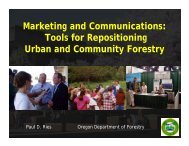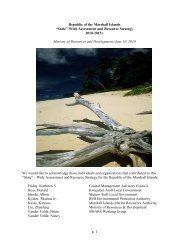Joint Letter to Senate Requesting Increase APHIS Funding
Joint Letter to Senate Requesting Increase APHIS Funding
Joint Letter to Senate Requesting Increase APHIS Funding
Create successful ePaper yourself
Turn your PDF publications into a flip-book with our unique Google optimized e-Paper software.
The Hardwood Federation<br />
National Association of State Departments of Agriculture<br />
National Association of State Foresters<br />
The Nature Conservancy<br />
Society of American Foresters<br />
March 16, 2007<br />
The Honorable Herb Kohl, Chairman<br />
Appropriations Subcommittee on Agriculture, Rural Development, Food and Drug<br />
Administration, and Related Agencies<br />
U.S. <strong>Senate</strong><br />
Washing<strong>to</strong>n, D.C. 20510<br />
The Honorable Robert Bennett, Ranking Member<br />
Appropriations Subcommittee on Agriculture, Rural Development, Food and Drug<br />
Administration, and Related Agencies<br />
U.S. <strong>Senate</strong><br />
Washing<strong>to</strong>n, D.C. 20510<br />
Dear Mr. Chairman and Ranking Member:<br />
Re: Fiscal Year 2008 Appropriation for the USDA Animal and<br />
Plant Health Inspection Service, Emerging Plant Pests<br />
The Hardwood Federation, National Association of State Departments of Agriculture,<br />
National Association of State Foresters, The Nature Conservancy, and Society of American<br />
Foresters urge the Subcommittee on Agriculture, Rural Development, Food and Drug<br />
Administration, and Related Agencies <strong>to</strong> increase funding substantially for the USDA Animal<br />
and Plant Health Inspection Service (<strong>APHIS</strong>) Emerging Plant Pests program. A sharp increase<br />
in funding is necessary in order <strong>to</strong> ensure adequate funding for eradication and control efforts<br />
targeting the emerald ash borer, Asian longhorned beetle, sudden oak death pathogen, and Sirex<br />
woodwasp. All four foreign and invasive species threaten trees in our forests and communities<br />
and related economic values worth hundreds of billions of dollars.<br />
This coalition represents a widely diverse group of stakeholders that are unified in support of the<br />
following program areas. This statement of common goals supplements individual letters <strong>to</strong> the<br />
Subcommitee submitted by several of these organizations. Some of these individual letters<br />
address additional issues.<br />
We seek an appropriation of $45 million for FY2008 <strong>to</strong> contain the emerald ash borer. The<br />
emerald ash borer threatens twelve species of ash across the continent, especially in the upper<br />
Midwest and Southeast. At risk are the $25 billion ash timber industry in the Northeast, street<br />
trees across the Nation valued at $20 <strong>to</strong> $60 billion, and myriad trees found in our neighborhoods
and parks. The emerald ash borer outbreak is large, but the core of the infestation remains in the<br />
lower peninsula of Michigan and neighboring portions of Indiana and Ohio. It is absolutely<br />
crucial that <strong>APHIS</strong> and its partners carry forward detection surveys and regula<strong>to</strong>ry and<br />
educational programs aimed at preventing movement of infested firewood, nursery s<strong>to</strong>ck, and<br />
other materials that spread the insect. <strong>APHIS</strong> and its state partners need additional funding in<br />
FY2008 <strong>to</strong> enable affected states <strong>to</strong> eradicate limited and isolated outbreaks found in Illinois,<br />
Maryland, Ohio, Indiana, and Michigan’s Upper Peninsula. Education, effective quarantine, and<br />
elimination of isolated infestations are necessary <strong>to</strong> create the potential <strong>to</strong> contain the core<br />
outbreak in and around Michigan.<br />
We seek an appropriation of $30 million for FY2008 <strong>to</strong> carry forward eradication of the few<br />
remaining populations of the Asian longhorned beetle. The Asian longhorned beetle poses an<br />
alarming threat <strong>to</strong> hardwood forests reaching from New England in<strong>to</strong> Minnesota and in the West,<br />
and <strong>to</strong> the hardwood timber, maple syrup, and autumn foliage <strong>to</strong>urism industries dependent on<br />
these forests. Also at risk are street trees across the Nation valued at more than $600 billion.<br />
Eradication has been successful in Chicago, proving the efficacy of this approach. Beetle<br />
populations in New Jersey are well on track for eradication. Only the populations in New York<br />
persist – and that is because funding for the New York effort has been reduced in past years <strong>to</strong><br />
focus the inadequate overall resources on Illinois and New Jersey. It is essential <strong>to</strong> provide<br />
sufficient funding now and in coming years <strong>to</strong> complete eradication in New Jersey and New<br />
York. The identification of another population on an island near Staten Island just this past week<br />
is an indication of the risk placed on the environment due <strong>to</strong> chronic under-funding of these<br />
programs.<br />
We support a request for $10 million in appropriations for FY2008 <strong>to</strong> contain a third damaging<br />
forest pest, the sudden oak death pathogen (also called the phy<strong>to</strong>phthora leaf and stem blight<br />
pathogen). This disease is a major threat <strong>to</strong> the nation’s nursery industry as it readily attacks<br />
species such as rhododendron, camellias and a long list of other common ornamentals. In<br />
addition, if sudden oak death does escape confinement, it threatens oaks in forests in Oregon and<br />
Washing<strong>to</strong>n as well as throughout the Appalachians, Ozarks, and even in<strong>to</strong> southern New<br />
England. Many wildlife species are dependent upon oaks for forage - the potential for<br />
devastating impacts on forests and wildlife is very real.<br />
The Sirex woodwasp is now found across much of New York State and two counties in<br />
Pennsylvania, as well as in Ontario, Canada. The woodwasp threatens valuable pine timber<br />
resources, especially those of the Southeast. It is essential that <strong>APHIS</strong> receive $3.6 million in<br />
FY2008 <strong>to</strong> implement a program including regula<strong>to</strong>ry and educational programs aimed at<br />
preventing movement of infested wood, nursery s<strong>to</strong>ck, and other materials that spread the insect.<br />
In addition <strong>to</strong> the appropriations needed <strong>to</strong> support these line items in <strong>APHIS</strong>’s Emerging Plant<br />
Pest program, the Hardwood Federation, National Association of State Departments of<br />
Agriculture, National Association of State Foresters, The Nature Conservancy, and Society of<br />
American Foresters also strongly support the Congress’ numerous statements urging the<br />
Administration <strong>to</strong> release emergency funds from the Commodity Credit Corporation (CCC)<br />
2
sufficient <strong>to</strong> enable full implementation of these management plans. The combination of the<br />
appropriations and the release of CCC funds is necessary <strong>to</strong> accomplish the needed tasks.<br />
Action now at the funding level requested would help ensure that these forest pests do not reach<br />
populations so large as <strong>to</strong> threaten trees in our forests and communities, garden nursery s<strong>to</strong>ck,<br />
and related economic activities worth hundreds of billions of dollars.<br />
Sincerely,<br />
Betsy Ward, Executive Direc<strong>to</strong>r,<br />
The Hardwood Federation<br />
1111 19th Street, NW<br />
Washing<strong>to</strong>n, DC 20036<br />
Rick Kirchhoff, Executive Direc<strong>to</strong>r<br />
National Association of State Departments of Agriculture<br />
1156 15 th Street, N.W.<br />
Washing<strong>to</strong>n, D.C. 2005<br />
C.T. “Kip” Howlett, Executive Direc<strong>to</strong>r<br />
National Association of State Foresters<br />
444 North Capi<strong>to</strong>l Street, N.W.<br />
Washing<strong>to</strong>n, D.C. 20001<br />
Michael Goergen, Executive Vice-President<br />
Society of American Foresters<br />
5400 Grosvenor Lane<br />
Bethesda, MD 20814<br />
Jimmie Powell, Direc<strong>to</strong>r, U.S. Government Relations<br />
The Nature Conservancy<br />
4245 North Fairfax Drive<br />
Arling<strong>to</strong>n, VA 22203<br />
3



